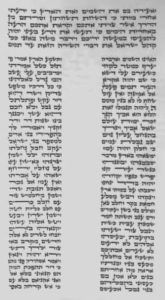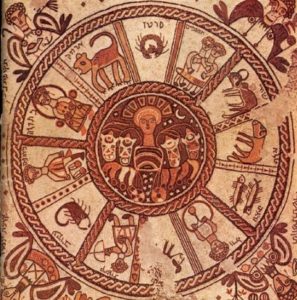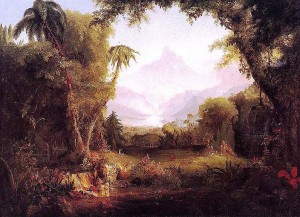The Torah begins with Beresheet, the famous account of Creation. In recent times, many have questioned the validity of this narrative in light of the findings of modern science. In reality, the Torah’s account is quite accurate in scientific terms, and the Jewish tradition described the origins of the universe and its age with stunning precision centuries before modern science caught up.

According to Science
The current scientific model holds that 13.7 billion years ago, the entire universe was compacted into a super tiny point with infinite density. For some unknown reason, this point suddenly burst in a massively vast and rapid expansion of energy and radiation. As the early universe cooled and expanded, particles began to form, and then whole atoms, starting with hydrogen. Hydrogen atoms fused into helium atoms, and later on heavy elements formed from further fusion in the cores of stars and their explosions. Everything that we see today—the entire universe and all matter within it—emerged from that initial expansion, “the Big Bang”.
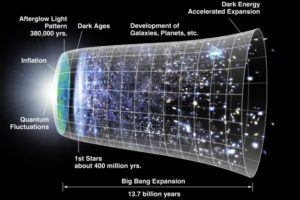 The evidence for a Big Bang is extensive. In fact, you can see some of it when you look at the “snow” on an old television that is not tuned to any channel. The antenna is picking up some of the cosmic microwave background radiation, the “afterglow” of the Big Bang. The entire universe is still glowing from that initial expansion! Popular physicist Brian Greene writes in his bestselling The Hidden Reality (pg. 43):
The evidence for a Big Bang is extensive. In fact, you can see some of it when you look at the “snow” on an old television that is not tuned to any channel. The antenna is picking up some of the cosmic microwave background radiation, the “afterglow” of the Big Bang. The entire universe is still glowing from that initial expansion! Popular physicist Brian Greene writes in his bestselling The Hidden Reality (pg. 43):
…if you were to shut off the sun, remove the other stars from the Milky Way, and even sweep away the most distant galaxies, space would not be black. To the human eye it would appear black, but if you could see radiation in the microwave part of the spectrum, then every which way you turned, you’d see a uniform glow. It’s origin? The origin.
The universe is glowing, it’s just that most people cannot see it because human eyes perceive only a very narrow part of the electromagnetic spectrum, which we call “visible light”. Light of a higher energy and frequency includes dangerous x-rays and gamma rays, while light of lower energy and frequency includes microwaves and radio waves. The seeming blackness of the universe is actually radiating with light—we simply cannot see it. Incredibly, this is precisely what the Torah states.
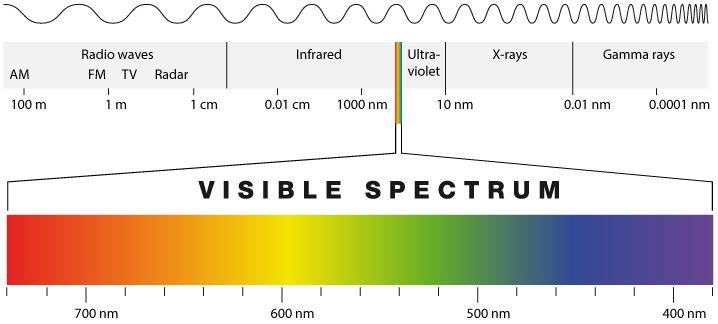
The electromagnetic spectrum. Visible light makes up just a tiny sliver of the spectrum. Some living organisms can see in UV or infrared wavelengths.
Zohar haRakia
We read in the Tanakh (Daniel 12:3) that “they who are wise shall shine as bright as the rakia…” The Torah tells us that God established a rakia (wrongly translated as “firmament”) on the second day of Creation, and this is where all the stars and planets are suspended (Genesis 1:15). The Talmud (Chagigah 12a), composed over 1500 years ago, further elaborates that above the earth is the vilon, the atmosphere that stretches over the planet, and beyond the vilon is the rakia, a vast expanse within which are all the stars. Beyond the rakia is a region called shechakim, the interface between the physical and spiritual realms, and further still are the highest levels of the Heavens, inhabited by angels and transcendental beings. From this, and other ancient sources, it is clear that rakia refers to outer space.
Daniel tells us that the wise will shine like the rakia, and goes on to state that “they who turn the many to righteousness [shall shine] as the stars”. We can understand how people might shine bright like stars, but why would Daniel say the rakia is shining? Outer space is totally dark! Of course, as Brian Greene described, today we know that the universe is indeed glowing.
One of the most ancient Jewish mystical texts is Sefer HaBahir. According to tradition, it dates back some two thousand years, and was first published at least seven hundred years ago. This book gets its name from another verse in the Tanakh (Job 37:21), which states “And now, men do not see the light that is bright [bahir] in the skies.” Once again, Scripture tells us that the universe is glowing with a bright light that humans are unable to perceive. Science has found that this glow comes from the Big Bang, and this too is accurately described by the most famous of Jewish mystical texts, the Zohar.

Cosmic Microwave Background Radiation, the glow of the universe, discovered in the 1960s by Robert Wilson and Jewish physicist Arno Penzias.
The Secret of Beresheet and the Big Bang
Like Sefer HaBahir, the Zohar was first published around seven hundred years ago, with its teachings dating back two millennia. The Zohar is a parasha-by-parasha commentary on the Torah, and naturally begins with the first section in describing Creation. The book gets its name from the above verse in Daniel which speaks of Zohar haRakia, the glow of the universe. It elaborates (I, 2a, 15a):
בְּשַׁעְתָּא דִּסְתִימָא דְכָל סְתִימִין בָּעָא לְאִתְגַּלְּיָא, עֲבַד בְּרֵישָׁא נְקוּדָה חֲדָא, וְדָא סָלֵיק לְמֶהֱוֵי מַחֲשָׁבָה. צַיֵּיר בָּהּ כָּל צִיּוּרִין חָקַק בָּהּ כָּל גְּלִיפִין… וְרָזָא דָא, בְּרֵאשִׁית בָּרָא אֱלֹהִים. זֹהַר, דְּמִנֵּיהּ כָּלְהוֹ מַאֲמָרוֹת אִתְבְּרִיאוּ בְּרָזָא דְאִתְפַּשְׁטוּתָא דִנְקוּדָה דְּזֹהַר סְתִים דָּא
When the Most Concealed One [God] began to create, He first made a singular point, with which he then brought forth all thought, drew all blueprints, and carved out all things… And the secret of “In the beginning, God created…” [Genesis 1:1] is radiance [zohar], from which all Utterances were created, in the secret of the expansion of that point of radiance.
Many centuries ago, the Zohar accurately and elegantly sums up the findings of modern science. God first created a tiny singular point which burst forth in light, and from which He “carved out” all things in existence. All of God’s Utterances (since the Torah says God created by speaking: “And God said ‘Let there be light.’”) came forth from the expansion of that initial primordial radiance.
Time is Relative
All that remains is the seeming contradiction in time. Science estimates 13.7 billion years, while the Torah speaks of six days. Of course, the nature of a “day” in the account of Creation is flexible, considering there was no Earth, sun, or moon until the third and fourth days (so how could there be a 24 hour day as we know it before this?) There were also no humans at this point, and the Torah describes Creation from the perspective of God, for whom “a thousand years is like one passing day” (Psalms 90:4). The fact that time runs differently for man and God actually highlights another scientific principle, as revealed by Albert Einstein.
Einstein’s theory of relativity holds that the passing of time varies depending on an entity’s speed. A person who could board a spaceship and fly near light-speed would experience very slow time. A few days for this person would be equivalent to many years on Earth. (This theme has been explored in countless science fiction books and films, including 2014’s Interstellar.) The Lubavitcher Rebbe often cited this fact to conclude that arguing about apparent space-time contradictions is therefore quite pointless. Meanwhile, physicist Gerald Schroeder has mathematically calculated that six days could be equivalent to 13.7 billion years when factoring in the universe’s expansion. After all, we are looking back in time at an ancient universe through human eyes, while God was looking forward in time from the universe’s first moments.
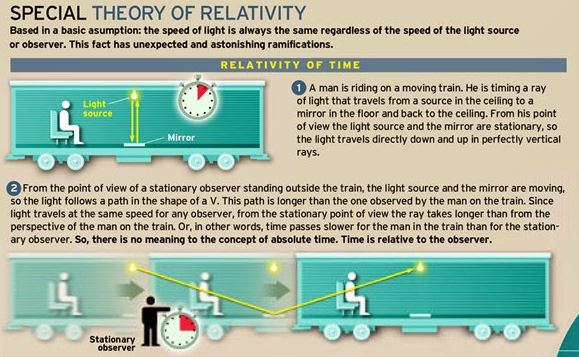
An infographic explaining the relativity of time. Note the conclusion: “there is no meaning to the concept of absolute time.” The whole debate of 6 days vs 13.7 billion years is therefore quite meaningless.
Physicist and Rabbi Aryeh Kaplan explored this issue extensively and cites multiple ancient Jewish texts that support the notion of a very ancient universe (see his book Kabbalah and the Age of the Universe). In multiple places, the Midrash states that before creating this world, God was creating and destroying many previous worlds (see, for example, Kohelet Rabbah 3:14), while the Talmud calculates that “there were 974 generations before Adam” (Chagigah 13b, Shabbat 88a).
On this last point, it has been shown that a generation according to the Torah is forty years (Numbers 32:13), and as we saw, a day for God is likened to 1000 human years (Psalms 90:4), therefore:
974 generations × 40 years/generation × 365 days/year × 1000 human years/divine day =
14.2 billion years
Compared to the current best estimate of science at 13.7 billion years, it is amazing that one can come to a very similar number by simply putting together a few Torah verses.
What we see from all of the above is that ancient Jewish texts describe the universe’s origins in absolutely perfect detail. And it is only in recent decades that science has finally caught up. In many other ways, too, science has a lot of catching up to do.
The above is an excerpt adapted from Garments of Light: 70 Illuminating Essays on the Weekly Torah Portion and Holidays. Click here to get the book!


